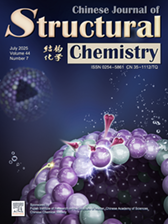
Cover Picture
Neodymium-doped hollow Ir/IrO2 nanospheres with low geometric iridium density enable excellent acidic water oxidation performance
Xiaoqian Wei, Hanyu Gao, Tiantian Wang, Zijian Li, Yanru Geng, Guiping Zheng, Min Gyu Kim, Haeseong Jang*, Xien Liu*, Qing Qin* Submit a Manuscript
Neodymium-doped hollow Ir/IrO2 nanospheres with low geometric iridium density enable excellent acidic water oxidation performance
Xiaoqian Wei, Hanyu Gao, Tiantian Wang, Zijian Li, Yanru Geng, Guiping Zheng, Min Gyu Kim, Haeseong Jang*, Xien Liu*, Qing Qin* Submit a Manuscript
Nickel phosphide modified TiO2 nanotube arrays for efficient PEC water splitting H2 generation
Yang Yang, Yan-Xin Chen*, Ao-Sheng She, Hao-Yan Shi, Wen Chen, Wei Wang, Hai-Long Wang, Ke-Xian Li, Yi-Hu Pu, Wei-Hua Yang, Xiu-Mei Lin, Can-Zhong Lu*
Chin. J. Struct. Chem., 2025, 44(7), 100623. DOI: 10.1016/j.cjsc.2025.100623
July 1, 2025
TiO2 nanotube arrays; Heterojunction; Photoelectrochemical water splitting; Visible-light response; Nickel-based catalyst
ABSTRACT
Photoelectrochemical (PEC) hydrogen production holds great promise for applications in energy production. A novel strategy characterized by simplicity, stability, and high efficiency was developed to significantly boost the PEC performance of TiO2 (anatase) nanotube arrays (TNTAs). This strategy entailed a series of treatments, including a conventional anodic oxidation (etching) process, a primary annealing treatment, and a secondary annealing treatment via impregnation. As a result, Nickel phosphide (Ni2P) was composited onto well-ordered titanium dioxide (anatase) nanotube array photoanodes (Ni2P/TNTAs), which exhibit hugely improved PEC hydrogen generation performance. A thorough and systematic investigation was conducted to comprehensively analyze the morphology, semiconductor band-gap structure, and PEC hydrogen production performance of the Ni2P/TNTAs composites. The experimental results demonstrated that under identical experimental circumstances, the measured photocurrent density of the Ni2P/TNTAs photoanode exhibited a 6.63-fold increase relative to that of the TNTAs. The hydrogen production rate of Ni2P/TNTAs reaches 182.96 μmol/cm2, 6.10 times higher than that of the pure TNTAs. The excellent interfacial charge transfer pathway at the Ni2P/TiO2 interface promoted photogenerated carrier separation and electron transfer from TiO2 to Ni2P. This method offers a valuable reference for designing highly efficient PEC hydrogen-production catalysts.







